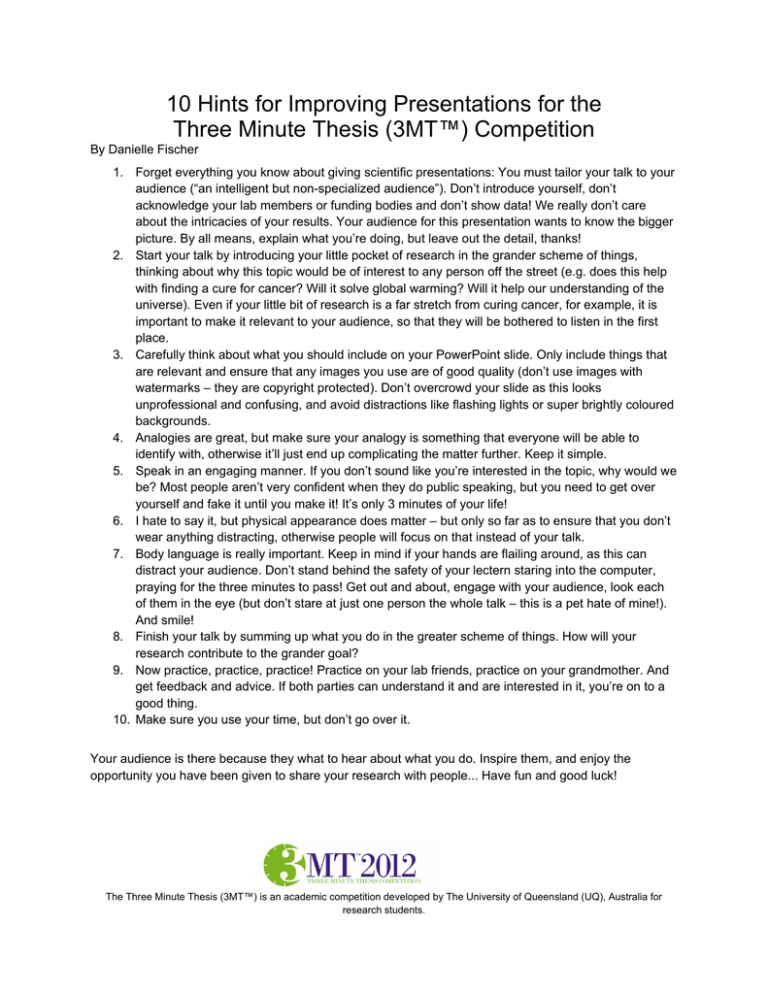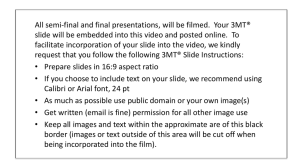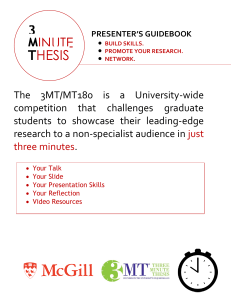10 Hints for Improving Presentations for the Three Minute Thesis
advertisement

10 Hints for Improving Presentations for the Three Minute Thesis (3MT™) Competition By Danielle Fischer 1. Forget everything you know about giving scientific presentations: You must tailor your talk to your audience (“an intelligent but non-specialized audience”). Don’t introduce yourself, don’t acknowledge your lab members or funding bodies and don’t show data! We really don’t care about the intricacies of your results. Your audience for this presentation wants to know the bigger picture. By all means, explain what you’re doing, but leave out the detail, thanks! 2. Start your talk by introducing your little pocket of research in the grander scheme of things, thinking about why this topic would be of interest to any person off the street (e.g. does this help with finding a cure for cancer? Will it solve global warming? Will it help our understanding of the universe). Even if your little bit of research is a far stretch from curing cancer, for example, it is important to make it relevant to your audience, so that they will be bothered to listen in the first place. 3. Carefully think about what you should include on your PowerPoint slide. Only include things that are relevant and ensure that any images you use are of good quality (don’t use images with watermarks – they are copyright protected). Don’t overcrowd your slide as this looks unprofessional and confusing, and avoid distractions like flashing lights or super brightly coloured backgrounds. 4. Analogies are great, but make sure your analogy is something that everyone will be able to identify with, otherwise it’ll just end up complicating the matter further. Keep it simple. 5. Speak in an engaging manner. If you don’t sound like you’re interested in the topic, why would we be? Most people aren’t very confident when they do public speaking, but you need to get over yourself and fake it until you make it! It’s only 3 minutes of your life! 6. I hate to say it, but physical appearance does matter – but only so far as to ensure that you don’t wear anything distracting, otherwise people will focus on that instead of your talk. 7. Body language is really important. Keep in mind if your hands are flailing around, as this can distract your audience. Don’t stand behind the safety of your lectern staring into the computer, praying for the three minutes to pass! Get out and about, engage with your audience, look each of them in the eye (but don’t stare at just one person the whole talk – this is a pet hate of mine!). And smile! 8. Finish your talk by summing up what you do in the greater scheme of things. How will your research contribute to the grander goal? 9. Now practice, practice, practice! Practice on your lab friends, practice on your grandmother. And get feedback and advice. If both parties can understand it and are interested in it, you’re on to a good thing. 10. Make sure you use your time, but don’t go over it. Your audience is there because they what to hear about what you do. Inspire them, and enjoy the opportunity you have been given to share your research with people... Have fun and good luck! The Three Minute Thesis (3MT™) is an academic competition developed by The University of Queensland (UQ), Australia for research students.


